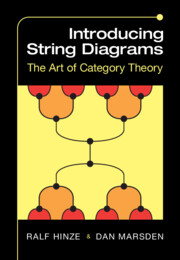
-
Select format
-
- Publisher:
- Cambridge University Press
- Publication date:
- July 2023
- August 2023
- ISBN:
- 9781009317825
- 9781009317863
- Dimensions:
- (244 x 170 mm)
- Weight & Pages:
- 0.51kg, 196 Pages
- Dimensions:
- Weight & Pages:
You may already have access via personal or institutional login
Book description
String diagrams are powerful graphical methods for reasoning in elementary category theory. Written in an informal expository style, this book provides a self-contained introduction to these diagrammatic techniques, ideal for graduate students and researchers. Much of the book is devoted to worked examples highlighting how best to use string diagrams to solve realistic problems in elementary category theory. A range of topics are explored from the perspective of string diagrams, including adjunctions, monad and comonads, Kleisli and Eilenberg–Moore categories, and endofunctor algebras and coalgebras. Careful attention is paid throughout to exploit the freedom of the graphical notation to draw diagrams that aid understanding and subsequent calculations. Each chapter contains plentiful exercises of varying levels of difficulty, suitable for self-study or for use by instructors.
Reviews
‘String diagrams have proven an indispensable tool in modern category theory, enabling intuitive graphical reasoning while doing away with much of the bookkeeping that tends to bog down equational arguments. This textbook introduces category theory by way of string diagrams, making it an excellent choice both for beginners in category theory, as well as for more experienced category theorists seeking to add string diagrammatic reasoning to their repertoire.’
Robin Kaarsgaard - University of Edinburgh
‘Well-chosen notation plays a vital role in constructive calculation because it facilitates the exploitation of algebraic properties. This book’s exemplary use of string diagrams in category theory will inspire and invigorate the calculational method. Peruse and ponder its colourful beauty.’
Roland Backhouse - University of Nottingham
Contents
Metrics
Altmetric attention score
Full text views
Full text views help Loading metrics...
Loading metrics...
* Views captured on Cambridge Core between #date#. This data will be updated every 24 hours.
Usage data cannot currently be displayed.
Accessibility standard: Unknown
Why this information is here
This section outlines the accessibility features of this content - including support for screen readers, full keyboard navigation and high-contrast display options. This may not be relevant for you.
Accessibility Information
Accessibility compliance for the PDF of this book is currently unknown and may be updated in the future.


